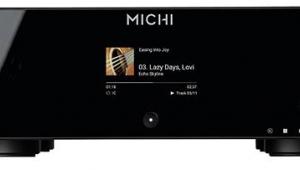Bel Canto Cd 2 (£2399)
Bel Canto’s little CD-2 strikes an ultra-minimal pose, with its diminutive green display, single rotary knob, brushed solid aluminium front panel and top-loading mechanism. The digital display shows the track number but precious little else, just a pause or play symbol alongside it, but pressing ‘Time’ on the handset, while in play or pause, shows the track time played.
The player is more versatile than it seems: the secret lies in the remote handset, which controls or sets everything. The CD-2 can be used without a preamp, as it has a built-in volume control, which can be operated either by the rotary knob, while in ‘Stop’ or ‘Play’ mode, or from the handset. The same knob selects the tracks while in ‘Pause’ mode. Alternatively, the volume can be fixed, via a rear-mounted push button, in which case the internal digital volume control circuitry is by-passed.
The CD-2 is fitted with a CD-Pro2, the top professional mechanism from Philips, which uses a magnetic puck to grip the CD securely. The centre shaft is polished to avoid damage to CDs. While not in use,
Bel Canto suggests leaving a CD on the axle to keep dust off the laser lens. Data is maintained through the player by Bel Canto’s ‘Ultra Clock’. Details are scant, but Bel Canto has been re-clocking since its first product, so it should know a thing or two about it.
PRIMARY TRANSPORT
Bel Canto describes the CD-2 as primarily a transport. The player takes the 16-bit/ 44.1kHz CD data and upsamples it to a new rate and bit depth for the internal or external DAC to process. It comes from the factory set to 24/96 data output but may be reset to 48kHz or 192kHz. The CD-2 is powered by an in-line 12V switch-mode power supply. This may seem a trifle odd for a high-end product, but Bel Canto says there are multi-stage power supplies inside.
For use as a CD player, the CD-2 is equipped with RCA phono and balanced XLR outputs. I used it in the unbalanced mode. Bel Canto suggests that for optimum sound quality, when used as a CD player, the sample frequency should be set to 192kHz to drive the internal 24/192 DAC. I wondered why it was not supplied like this from the factory, but in this mode all the digital outputs are disabled, which would cause some frustration if used as a transport without having fully read the manual.
HAZE LIFTING
First impressions of the CD-2 were of a clean, clear smooth sound with nicely extended treble, good depth and detail. The soundstage was wide and deep. Realising the upsampled data comes factory set to 24/96, I switched it to the recommended 24/192 and it was as though a haze had lifted, subtly but noticeably improving in depth, realism and transparency.
I had also started off by using the digital volume control, but selecting the fixed output using the rear push button brought about further improvements in sound quality, bringing a bit more warmth, depth, openness and transparency.
With the new setting and playing ‘Bess You Is My Woman’ from Porgy and Bess [Columbia Legacy CK 65141], Miles’ horn retained its clean edge, and pin-sharp imagery, but the reverberation around it opened out and all the instruments took on a more convincing life. Small improvements, though not in themselves dramatic, cumulatively brought about genuine benefits. Logically, one would expect that reducing the number crunching by bypassing the volume control should be beneficial, and it is.
Reproduction from the CD-2 was convincing, combining crisp clarity with control, while avoiding grain or glare. Playing ‘Buzzard Song’, (also from Porgy and Bess) for instance, the metallic swish of brush on cymbals and rattle of riding rivets is something the CD-2 reproduces clearly and cleanly, without ‘mush’ or ‘clumping’ of micro details. Though treble seemed to extend up and up, it was never unnaturally bright, harsh or grainy. It was a finely judged balance between detail, smoothness and clarity – and my ears were still intact after the searing horn intro.
STEINWAY SOUND
Mozart’s Piano Concerto No 21 (K 47) in C Major [Howard Shelly on piano in St Jude’s Church, London on Chandos CHAN 9409] pointed up the CD-2’s fine sound staging and fluidity. Here was a lovely Steinway sound set in a deep wide soundstage. The music ebbed and flowed beautifully. Strings were open yet sweet.
Playing the Allegro from Beethoven’s Sonata for Piano and Violin in A Op 30, No 1 with Martha Argerich on piano and Gidon Kremer on violin [DGG 445 652-2], this crisp 4DD recording showed a vivacious piano sound placed firmly in the acoustic with the vividly clear violin, but again it was never aggressive.
Switching back to the standard factory settings, however, saw the Beethoven lose some of that vitality and immediacy. So, all in all, when set optimally, the CD-2 played music in a vital, yet even-handed and convincing fashion.
VERDICT
The CD-2 may be primarily positioned as a transport, but it makes a mighty fine CD player when in 24/192 ‘fixed output’ mode. It is minimalist in the extreme, but what is lacks in bling it more than makes up for in sound quality. With pin-sharp imagery, fine sound staging and transparency, it is inherently refined and musical in presentation.
Originally publshed in the April 2008 issue
























































